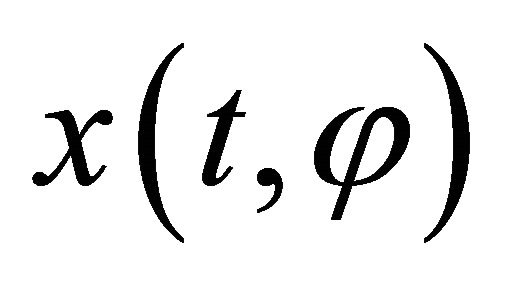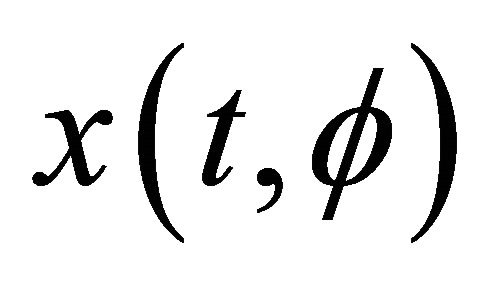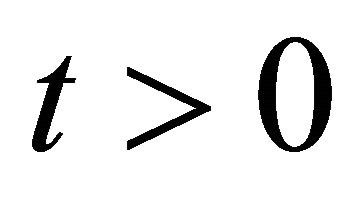Int'l J. of Communications, Network and System Sciences
Vol. 5 No. 12 (2012) , Article ID: 25435 , 5 pages DOI:10.4236/ijcns.2012.512085
Periodic Solutions of Cohen-Grossberg-Type BAM Neural Networks with Time-Varying Delays
1Institute of Applied Mathematics, Shijiazhuang Mechanical Engineering College, Shijiazhuang, China
2College of Mathematics and Information Science, Shaanxi Normal University, Xi’an, China
Email: lqmmath@yahoo.com.cn
Received September 12, 2012; revised October 25, 2012; accepted November 6, 2012
Keywords: Cohen-Grossberg Neural Networks; BAM Neural Networks; Periodic Solution; Delay; Global Stability
ABSTRACT
Sufficient conditions to guarantee the existence and global exponential stability of periodic solutions of a CohenGrossberg-type BAM neural network are established by suitable mathe matical transformation.
1. Introduction
Many important results on the existence and global exponential stability of equilibria of neural networks with time delays have been widely investigated and successfully applied to signal processing system. However, the research of neural networks involves not only the dynamic analysis of equilibrium point but also that of periodic oscillatory solution. In practice, the dynamic behavior of periodic oscillatory solution is very important in learning theory [1,2], which is motivated by the fact that learning usually requires repetition, some important results for periodic solutions of Hopfield neural networks or Cohen-Grossberg neural networks with delays have been obtained in Refs. [3-15].
The objective of this paper is to study the existence and global exponential stability of periodic solutios of a class of Cohen-Grossberg-type BAM neural networks (CGBAMNNs) with time-varying delays by suitable mathematical transformation.
The rest of this paper is organized as follows: preliminaries are given in Section 2. Sufficient conditions which guarantee the existence and global exponential stability of periodic solutions for the CGBAMNNs are established Section 3. An example is given in Section 4 to demonstrate the main results.
2. Preliminaries
Consider the following periodic CGNNs with timevarying delays (see Equation (1)):
For ,
,  and
and .
.  denote the state variables of the ith neuron,
denote the state variables of the ith neuron,  denote the signal functions of the jth neuron at time t;
denote the signal functions of the jth neuron at time t;  denote inputs of the ith neuron at time t;
denote inputs of the ith neuron at time t;  represent amplification functions;
represent amplification functions;  are appropriately behaved functions;
are appropriately behaved functions;  and
and  and are connection weights of the neural networks, respectively;
and are connection weights of the neural networks, respectively;  are positive constants which correspond to the neuronal gains associated with the neuronal activations;
are positive constants which correspond to the neuronal gains associated with the neuronal activations;  correspond to the finite speed of the axonal signal transmission at time t and there exist constants
correspond to the finite speed of the axonal signal transmission at time t and there exist constants  such that
such that ,
,  and
and  are all continuously periodic functions on [0, +∞) with common period T > 0.
are all continuously periodic functions on [0, +∞) with common period T > 0.
Throughout this paper, we assume for system (1) that
(H1) Amplification functions  are continuous and there exist constants
are continuous and there exist constants  such that
such that  for
for .
.
(H2)  are T-periodic about the first argument and there exist continuous T-periodic functions
are T-periodic about the first argument and there exist continuous T-periodic functions  such that
such that
 .
.
(H3) For activation functions , there exist positive constants
, there exist positive constants  such that
such that
 (1)
(1)

For any continuous function  on
on ,
, 
and  denote
denote  and
and respectively.
respectively.
For any
 define
define
 and for any
and for any
 ,
,
 define
define

in which
 .
.
Denote

is continuous on .
.
Then  is a Banach space with respect to
is a Banach space with respect to .
.
The initial conditions of system (1) are given by
 (2)
(2)
where
 .
.
Le  denotes any solution of the system (1) with initial value
denotes any solution of the system (1) with initial value .
.
Definition 1. An solution  of system (1) is said to be globally exponentially stable, for any solutions
of system (1) is said to be globally exponentially stable, for any solutions  of the system (1), if there exist positive constant
of the system (1), if there exist positive constant  and
and  such that
such that
 (3)
(3)
Lemma 1. Under assumptions (H1)-(H3), system (1) has a T-periodic solution which is globally exponentially stable, if the following conditions hold.
(H4) Assume that there exist constants  such that
such that ,
, .
.
(H5)  is a nonsingular M-matrix, where
is a nonsingular M-matrix, where

Proof. If , the model (2.1) in [14] reduces to the system (1), we know that Lemma 1 holds from Theorem 3.1 with r = 1 in [14].
, the model (2.1) in [14] reduces to the system (1), we know that Lemma 1 holds from Theorem 3.1 with r = 1 in [14].
3. Periodic Solutions of CGBAMNNs with Time Varying Delays
Consider the following CGBAMNNs with time-varying delays:
 (4)
(4)
for ,
,  and
and 
 and
and  denote the state variables,
denote the state variables,  and
and  denote the signal functions,
denote the signal functions,  and
and  denote inputs;
denote inputs;  and
and  represent amplification functions;
represent amplification functions;  and
and  are appropriately behaved functions;
are appropriately behaved functions; ,
,  ,
,  and
and  are the connection weights and
are the connection weights and ,
,  are positive constants, which correspond to the neuronal gains associated with the neuronal activations; Time delays
are positive constants, which correspond to the neuronal gains associated with the neuronal activations; Time delays  and
and  correspond to the finite speed of the axonal signal transmission at time t and there exist constants
correspond to the finite speed of the axonal signal transmission at time t and there exist constants  and
and  such that
such that ,
, ;
; ,
,  ,
,  ,
,  ,
,  ,
,  ,
,  and
and  are all continuously periodic functions on
are all continuously periodic functions on  with common period
with common period .
.
Throughout this paper, we assume for system (4) that
(H6) Amplification functions  and
and  are continuous and there exist positive constants
are continuous and there exist positive constants  and
and  such that
such that ,
,  ,
, .
.
(H7) ,
,  are T-periodic about the first argument and there exist continuous T-periodic functions
are T-periodic about the first argument and there exist continuous T-periodic functions  and
and  such that
such that

(H8) For activation functions and
and , there exist constants
, there exist constants  and
and  such that
such that

The initial conditions of system (4) are given by

where
 ,
,

Theorem 1. Under assumptions (H6)-(H10), system (4) has a T-periodic solution which is globally exponentially stable, if the following condition holds.
(H9) Assume that there exist constants  and
and  such that
such that  and
and  hold for
hold for .
.
(H10) The following is a nonsingular M-matrix, and
is a nonsingular M-matrix, and
 (5)
(5)
in which

Proof. Let
 (6)
(6)
It follows that system (4) can be rewrote as
 (7)
(7)
for .
.
Initial conditions are given by
 (8)
(8)
Hence system (7) is a special case of system (1) in mathematical form in which there are n+m neurons and connection weights  for
for  and
and . Under conditions (H6)-(H10), from Lemma 1, we obtain that system (7) has a T-periodic solution which is globally exponentially stable, if the following matrix
. Under conditions (H6)-(H10), from Lemma 1, we obtain that system (7) has a T-periodic solution which is globally exponentially stable, if the following matrix  is a M-matrix, and
is a M-matrix, and
 (9)
(9)
where


in which 
Then, we know from (6) and (9) that Theorem 1 holds.
4. An Example
Consider the following CGBAMNNs with time delays:
 (10)
(10)


Figure 1. Time response of state variables x1, y1 and phase plot in space (t, x1, y1) for system (10).
It is easy to verify system (10) satisfies (H6)-(H9). In addition, system (10) satisfies (H10) because

is a nonsingular M-matrix. According to Theorem 1, system (10) has a 2-periodic solution which is globally exponentially stable. Figure 1 shows the dynamic behaveiors of system (10) with initial conditions (0.8, 0.9).
Remark 1 The results in [3,15] have more restrictions than the results in this paper because conditions for the results in [3,15] are relevant to amplification functions. In addition, in view of proof of Theorem 1, since CGBAMNNs with time-varying delays is a special case of CGNNs time-varying delays in form as BAM neural networks is a special case of Hopfield neural networks, many results of CGBAMNNs can be directly obtained from the ones of CGNNs, needing no repetitive discussions, which coincide with the conclusion in [16,17].
REFERENCES
- S. Townley, S. Ilchmann, A. Weiss, et al., “Existence and Learning of Oscillations in Recurrent Neural Networks,” IEEE Transactions on Neural Networks, Vol. 11, No. 1, 2000, pp. 205-214. doi:10.1109/72.822523
- Z. Huang and Y. Xia, “Exponential Periodic Attractor of Impulsive BAM Networks with finite Distributed Delays,” Chaos, Solitons & Fractals, Vol. 39, No. 1, 2009, pp. 373-384. doi:10.1016/j.chaos.2007.04.014
- H. Xiang and J. Cao, “Exponential Stability of Periodic Solution to Cohen-Grossberg-Type BAM Networks with Time-Varying Delays,” Neurocomputing, Vol. 72, No. 7-9, 2009, pp. 1702-1711. doi:10.1016/j.neucom.2008.07.006
- Y. Li, X. Chen and L. Zhao, “Stability and Existence of Periodic Solutions to Delayed Cohen-Grossberg BAM Neural Networks with Impulses on Timescales,” Neurocomputing, Vol. 72, No. 7-9, 2009, pp. 1621-1630. doi:10.1016/j.neucom.2008.08.010
- Q. Song, J. Cao and Z. Zhao, “Periodic Solutions and Its Exponential Stability of Reaction-Diffusion Recurrent Neural Networks with Continuously Distributed Delays,” Nonlinear Analysis: Real World Applications, Vol. 7, No. 1, 2006, pp. 65-80. doi:10.1016/j.nonrwa.2005.01.004
- T. Zhou, A. Chen and Y. Zhou, “Existence and Global Exponential Stability of Periodic Solution to BAM Neural Networks with Periodic Coefficient and Continuously Distributed Delays,” Physics Letters A, Vol. 343, No. 5, 2005, pp. 336-350. doi:10.1016/j.physleta.2005.02.081
- J. Cao and J. Liang, “Boundedness and Stability for Cohen-Grossberg Neural Network with Time-Varying Delays,” Journal of Mathematical Analysis and Applications, Vol. 296, No. 2, 2004, pp. 665-685. doi:10.1016/j.jmaa.2004.04.039
- H. Wang, X. Liao and C. Li, “Existence and Exponential Stability of Periodic Solution of BAM Neural Networks with Impulse and Time-Varying Delay,” Chaos, Solitons & Fractals, Vol. 33, No. 3, 2007, pp. 1028-1039. doi:10.1016/j.chaos.2006.01.112
- Q. Song and Z. Wang, “An Analysis on Existence and Global Exponential Stability of Periodic Solutions for BAM Neural Networks with Time-Varying Delays,” Nonlinear Analysis: Real World Applications, Vol. 8, No. 4, 2007, pp. 1224-1234. doi:10.1016/j.nonrwa.2006.07.002
- Y. Li and J. Wang, “Analysis on the Global Exponential Stability and Existence of Periodic Solutions for NonAutonomous Hybrid BAM Neural Networks with Distributed Delays and Impulses,” Computers & Mathematics with Applications, Vol. 56, No. 9, 2008, pp. 2256- 2267. doi:10.1016/j.camwa.2008.03.048
- X. Yang, “Existence and Global Exponential Stability of Periodic Solution for Cohen-Grossberg Shunting Inhibitory Cellular Neural Networks with Delays and Impulses,” Neurocomputing, Vol. 72, No. 10-12, 2009, pp. 2219- 2226. doi:10.1016/j.neucom.2009.01.003
- Q. Zhu, F. Liang and Q. Zhang, “Global Exponential Stability of Cohen-Grossberg Neural Networks with TimeVarying Delays and Impulses,” Journal of Shanghai University, Vol. 13, No. 3, 2009, pp. 255-259. doi:10.1007/s11741-009-0310-3
- C. Li and S. Yang, “Existence and Attractivity of Periodic Solutions to Nonautonomous Cohen-Grossberg Neural Networks with Time Delays,” Chaos, Solitons & Fractals, Vol. 41, No. 3, 2009, pp. 1235-1244. doi:10.1016/j.chaos.2008.05.005
- Q. Liu, “Periodic Solutions of Higher-Order Cohen-Grossberg Neural Networks with Time-Varying Delays,” Advances in Differential Equations and Control Process, Vol. 6, No. 1, 2010, pp. 1-14.
- A. Chen and Q. Gu, “Periodic Solution to BAM-Type Cohen-Grossberg Neural Network with Time-Varying Delays,” Acta Mathematicae Applicatae Sinica, Vol. 27, No. 3, 2011, pp. 427-442. doi:10.1007/s10255-011-0082-x
- J. Olivera, “Global Stability of a Cohen-Grossberg Neural Network with Both Time-Varying and Continuous Distributed Delays,” Nonlinear Analysis: Real World Applications, Vol. 12, No. 5, 2011, pp. 2861-2870. doi:10.1016/j.nonrwa.2011.04.012
- Q. Liu and R. Xu, “Periodic Solutions of a Cohen-Grossberg-Type BAM Neural Networks with Distributed Delays and Impulses,” Journal of Applied Mathematics, Vol. 2012, 2012, 17 p.

